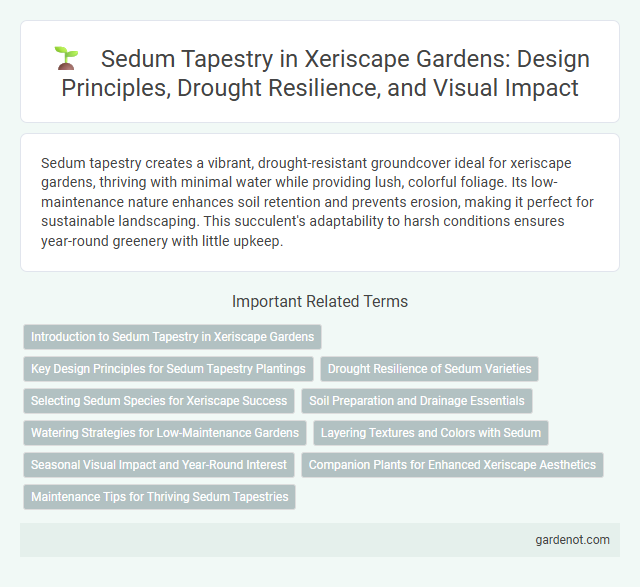Sedum tapestry creates a vibrant, drought-resistant groundcover ideal for xeriscape gardens, thriving with minimal water while providing lush, colorful foliage. Its low-maintenance nature enhances soil retention and prevents erosion, making it perfect for sustainable landscaping. This succulent's adaptability to harsh conditions ensures year-round greenery with little upkeep.
Introduction to Sedum Tapestry in Xeriscape Gardens
Sedum tapestry is a popular choice in xeriscape gardens due to its drought-tolerant nature and low water requirements. This succulent groundcover features vibrant, fleshy leaves that create a dense, colorful mat, enhancing soil retention and reducing evaporation. Its ability to thrive in poor, well-drained soils makes it ideal for sustainable landscaping focused on water conservation.
Key Design Principles for Sedum Tapestry Plantings
Sedum tapestry plantings thrive by emphasizing key design principles such as selecting diverse Sedum species with varying textures, colors, and growth habits to create visual interest and seasonal appeal. Optimizing soil conditions with well-drained, low-nutrient substrates supports healthy growth and drought tolerance inherent to xeriscape landscapes. Strategic spacing and layering enhance air circulation and minimize water competition, ensuring sustainable, low-maintenance Sedum tapestry installations.
Drought Resilience of Sedum Varieties
Sedum tapestry is an exceptional example of drought resilience among sedum varieties, thriving with minimal water due to its succulent leaves that store moisture efficiently. These hardy plants maintain vibrant foliage and robust growth even in prolonged dry conditions, making them ideal for xeriscape landscaping. Their adaptability to arid environments reduces irrigation needs, promoting sustainable water conservation in garden designs.
Selecting Sedum Species for Xeriscape Success
Selecting Sedum species for xeriscape success involves prioritizing drought-tolerant varieties such as Sedum album, Sedum spurium, and Sedum reflexum, known for their low water requirements and resilience. These hardy succulents thrive in well-drained soil and full sun, making them ideal for water-efficient landscaping. Incorporating diverse Sedum species enhances ground cover density, reduces soil erosion, and supports sustainable xeriscaping practices.
Soil Preparation and Drainage Essentials
Sedum tapestry thrives in well-drained, sandy or gritty soil that prevents waterlogging and root rot. Soil preparation should include incorporating coarse sand or fine gravel to enhance drainage and avoid compaction. Proper grading or raised beds ensure excess water flows away from the roots, essential for maintaining healthy sedum growth in xeriscape gardens.
Watering Strategies for Low-Maintenance Gardens
Sedum tapestry thrives in xeriscape gardens due to its drought-tolerant nature, requiring minimal watering once established. Watering strategies emphasize infrequent, deep irrigation to promote strong root development while preventing overwatering that can cause root rot. Implementing drip irrigation or soaker hoses ensures efficient water use, maintaining healthy Sedum growth with minimal maintenance in low-water landscapes.
Layering Textures and Colors with Sedum
Sedum tapestry excels in layering textures and colors by combining various Sedum varieties with contrasting leaf shapes and vibrant hues, creating a dynamic ground cover. Its succulent foliage ranges from deep greens to rich reds and purples, offering seasonal color shifts that enhance xeriscape designs. This plant's low-maintenance nature and drought tolerance make it ideal for sustainable landscaping with visual depth.
Seasonal Visual Impact and Year-Round Interest
Sedum Tapestry delivers vibrant seasonal visual impact with its shifting palette of deep burgundy, bright pinks, and lime greens, creating texture and depth throughout the growing season. Its succulent foliage remains attractive and robust during dry summer months, supporting xeriscape garden sustainability. In winter, Sedum Tapestry maintains structure and subtle color, providing year-round interest in low-water landscapes.
Companion Plants for Enhanced Xeriscape Aesthetics
Sedum tapestry thrives alongside drought-tolerant companions such as ornamental grasses, lavender, and yucca, enhancing xeriscape aesthetics through contrasting textures and colors. These companion plants complement sedum's vibrant succulence while conserving water efficiently in dry landscapes. Strategic planting of sedum tapestry with hardy perennials improves soil retention and provides visual depth, maximizing the ecological and ornamental value of xeriscape gardens.
Maintenance Tips for Thriving Sedum Tapestries
Sedum tapestries thrive best in well-drained soil with minimal watering, as these drought-tolerant succulents store water in their leaves. Pruning spent flowers and removing dead stems promotes healthy growth and prevents overcrowding, ensuring vibrant, dense coverage. Applying a balanced, slow-release fertilizer once in early spring supports robust development without encouraging excessive foliage.
Sedum tapestry Infographic

 gardenot.com
gardenot.com